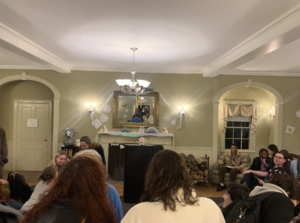David Lynch’s television series Twin Peaks estranges the small-town aesthetic in a notable display of the uncanny. Twin Peaks features a number of absurdities corroding: a woman whispers to a log; Leland Palmer dances at bars and other public spaces, using music to cope with the death of his daughter Laura, only to break down before an often unblinking public in scenes built on the contrast between a freewheeling tone (composed through music) and blistering grief; Laura Palmer, before her murder, behind her family’s back, has been doing drugs and posing for a risqué magazine at a gambling joint in Canada.
Neighborhoods often strive for pristine social images, however, bursts of reality peek through their performance, as rumors and public encounters propagate. Illusory, performative, communal, and simply odd—neighborhoods are unique spaces estranged by the complexities of their dynamics, the singularity of their inhabitants, and the social pressures of the society they inhabit.
Hiromi Kawakami’s interconnected short-story book People from My Neighborhood—translated from Japanese by Ted Goossen—participates in this estrangement. In snapshots of a town riddled with localized oddities (an old man with two shadows, a drawer full of white and milky doll brains, a baby that doesn’t age, a smelly dove that grows into a man hidden in a closet by a lonely child,) Kawakami crafts a book of absurdity, with stories of whispers and memories, an interwoven network of the sublime exploring the fine line of sociability and privacy. We linger in the strangeness of her book, peering out into the driveways of white shingled homes with fresh-cut lawns and wonder what is going on behind closed doors.
Uncle Round was an adept gambler: “He would line up ten pigs, and people would compete to guess how many flies were buzzing around each one.” Sakai, a young boy who had just moved into town, was ecstatic. Round was both ringmaster and virtuoso of this game, using impeccable kinetic vision to discern the exact number of flies flitting around a pig at any moment. Despite this, Sakai usurped Uncle Round. One evening, he “pulled out a wad of notes and waved it under my nose. It was nearly an inch thick,” according to the unnamed narrator, who once visited Round and lost thousands of yen.
Sakai continued visiting Round, winning so much money that he went out of business: “Rumor had it that Sakai was cheating, but no one was able to work out exactly how.” Round disappeared, and Sakai took over, renovating the business with “a cabaret club, a shady bar, an udon shop… and draped the pigs, who had been naked in Uncle Round’s day, in glittering outfits made of gold and silver thread.” But another rumor spread that Round was back in town. Sakai disappeared; Round confessed he tried to kill the boy out of revenge, but he transformed into a swarm of flies when Round tried to stab him.
Kawakami’s prose behaves as rumors and whispers. Round’s narrative, for instance, unfolds from gossip; the narrator remains distant, recounting the story not in visceral, descriptive passages, but as snippets of gossip with others (“I had the opportunity to ask Uncle Round in private what the real story was.”) Details of each event are abandoned, and instead, a local contributes their own voice as they recall the town’s ephemeral history (in another story, the narrator states “We heard from people who lived in the neighborhood next to ours…that [Michio and Kanae’s sister] had been brutally tortured” for plotting a revolution)—they lie on the fringes of narrative, retelling the rumors and stories of an entire town in diluted bursts.
In presenting narratives in the form of rumors, Kawakami provides a voice for estrangement in the small-town dynamic. Small-towns relish in gossip, after all: “That girl didn’t wanna die,” says the Lisbon’s neighbors in Sofia Coppola’s The Virgin Suicides after Cecilia Lisbon’s suicide. “She just wanted to get out of that house.” We know nothing of the isolation, the overbearing parents; only the whispered perversions of “I heards” and “X told mes;” the stale blue interior of the Lisbon home refuses to penetrate the gold hues of an ideal suburbia.
A distant voice gathers details from others, hardly penetrating the mask of sociability, while further avoiding it through gossip (Cecilia’s story, after all, is told through adolescent boys consistently sexualizing and participating in the neighborly rumor mill.) Kawakami’s voice of the village permeates the text with the hazy droll of rumor (is Uncle Round lying? Are any of the rumors true? Did Sakai really turn into flies? privacy is nonexistent, and instead the public gaze churns the narrative) in terse, spare, writing, almost to a fault, and yet, the prose electrifies me with the deliciousness of its gossip.
People suffering from the extremely contagious pigeonitis “sound like a pigeon when they try to talk…their body also begins to take on pigeon-like characteristics.” If I were to contract pigeonitis, my chest would stick out, my eyes would grow wide, beady, round, my gait bobbing forward in staccato, tip-taps on concrete sidewalks “all herky-jerky.” After the physical transformation, I would lay some eggs, perhaps, or eat insects and bugs and defecate on passers-by from a roost in a tree and coo, abandoning all responsibilities, sailing “blissfully through the chaos of [everyday life].”
But no one talked about their pigeon days: “We all kept quiet…about what had taken place during that time, so that the solidarity of our community was actually improved.” This collective memory intrigues Goossen. “Almost no one mentions it once it’s over,” he says in an interview for Asymptote Magazine, “revealing [the idea of] communal memory at large—how communities wish to remember and present themselves, and what they choose to forget.”
Despite the absurdity of Kawakami’s story, it grounds itself in this imaginable scenario. The town was caught in a spell of chaos, and yet, rather than moving on, a hush fell over the village (only with Kiyoshi—the only child to avoid illness—do they mention the pandemic, sublimating their experience through their teasing.) The contradiction of reality and fantasy coincides with tension between the spoken and unspoken intimacies of a neighborhood. The unified town attempts to maintain its normalcy through communal memory, a desire to find respite in the everyday minutiae of their lives, despite the urge to peck the ground.
No one plays with Kanae’s sister. During lunch one day at school, she pursues an object she saw in a prophetic dream, where an old woman stabbed her husband (“Isn’t marriage wonderful…you can hurt each other like this anytime you like!”) and from the wound in his mouth an object emerges. Kanae found this object on an animal trail during this lunchtime and found a creature resembling a white, stinky dove.
The dove grew—losing its stench—into a boy about the same age as Kanae’s sister, who called him Grandpa. She kept Grandpa in the crawl space in her bedroom, where they “engaged in lavish amounts of sex” until they were married. Kanae’s sister became a medium, and at sixty years old, a meteor threatened the earth. In another prophetic dream, she saw Grandpa “[turning] away the meteor.” However, in order to do so, he had to die in the process. Grandpa turned back into a dove, and flew into the meteor, destroying it. Kanae’s sister was regarded as a hero, and yet, she was riddled with melancholy. She longed “to smell that stench just one more time.”
Kanae’s sister’s narrative burns with tension between the social and self-identity. She is drawn to the white dove because she does not fit in with other students, and the rest of the neighborhood scorns her. The townspeople ridicule Kanae as well. After a spell of juvenile delinquency and “impure relations” with men and women, she leaves her neighborhood to study in France, and when she returns, a woman calls her the “ “pride of our hometown…’ the very same woman who had told me about Kanae’s impure relations.” The public gaze crafts evidence not from truths, but impressions of sociability and moral acceptance. Rumor and isolation estrange both girls—driving them to seek refuge elsewhere, in doves and behaviors deemed unfit by the townspeople (but, strangely, are never named, only “impure”)—even though they are likewise beloved; the communal memory shifts, creating its own mythos, resetting the social scrim to protect their reputation.
Kawakami’s fantastical town rails against itself, proliferating and quelling the absurdities that define it, for the sake of an ephemeral social imagination; like the golden hue lining the suburban streets in Sofia Coppola’s Virgin Suicides—masking her town in a glow of middle-and-upper-class success, the townspeople (despite the underlying, dark truths around them) attempt to keep their social illusions alive.
Kawakami unravels small-town dynamics with an extreme absurdity that (despite the outlandishness of the events,) behaves as though we were ourselves peering through a living room window, our elbows propped up against the back of a black leather sofa, peering between the curtains at a neighbor at the center of a public panopticon.








Be First to Comment